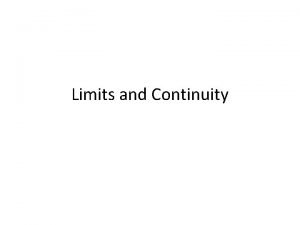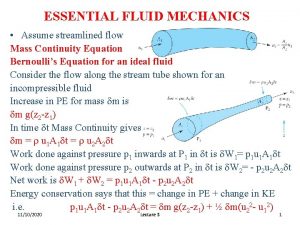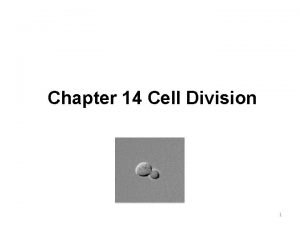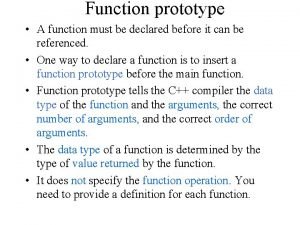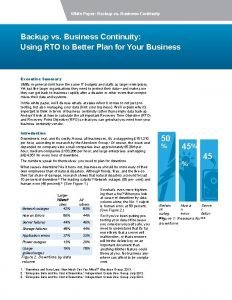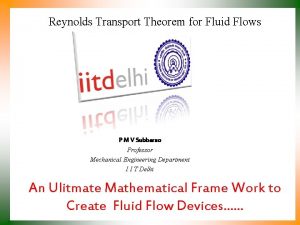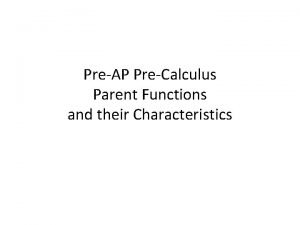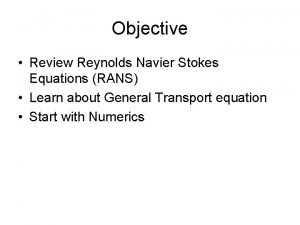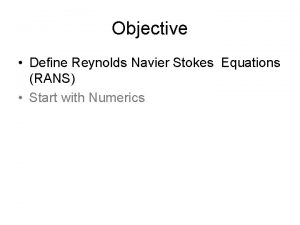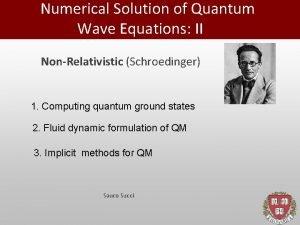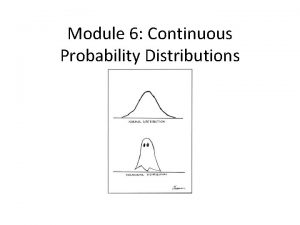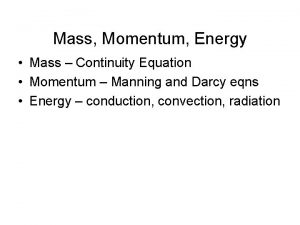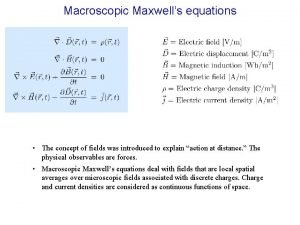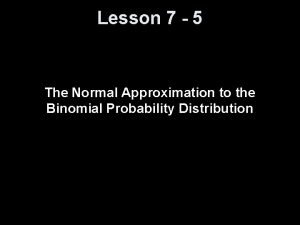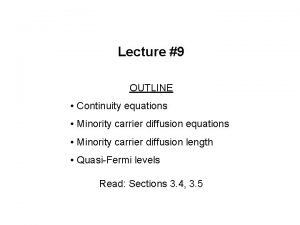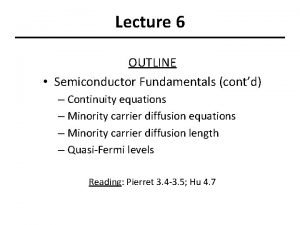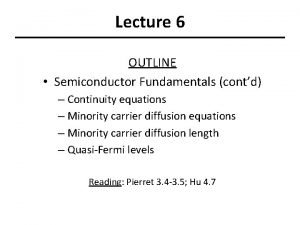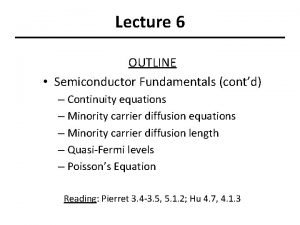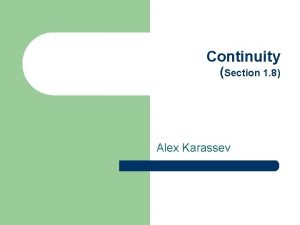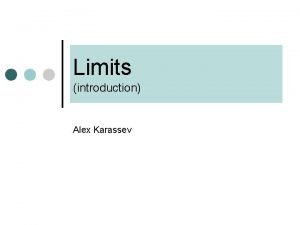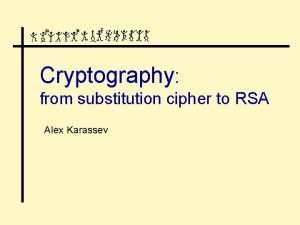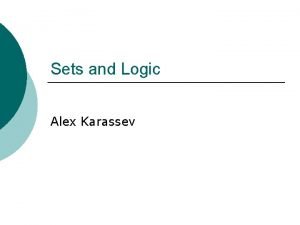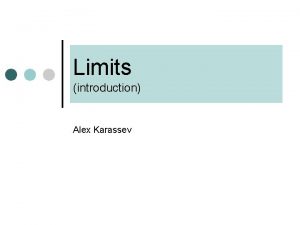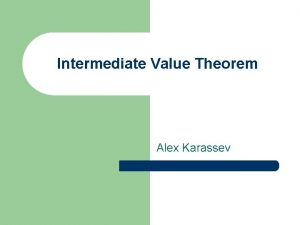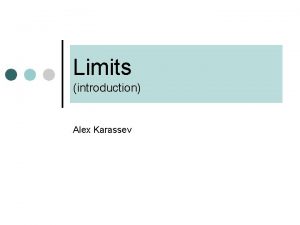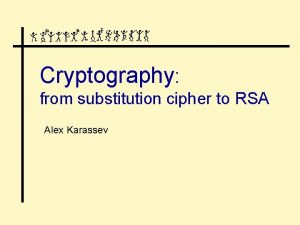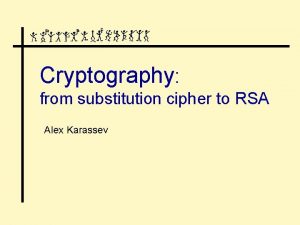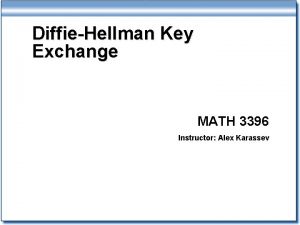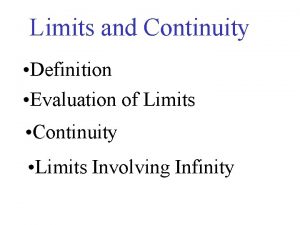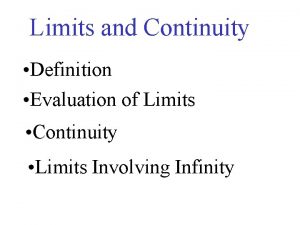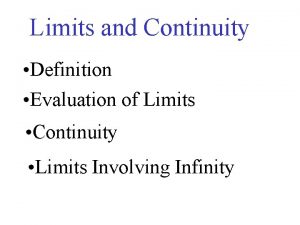Continuity Alex Karassev Definition l A function f












![Intermediate Value Theorem (IVT) l l f is continuous on [a, b] N is Intermediate Value Theorem (IVT) l l f is continuous on [a, b] N is](https://slidetodoc.com/presentation_image_h/0091a361e469b91c90f6ad9e1f68cee5/image-13.jpg)
![Intermediate Value Theorem (IVT) l l f is continuous on [a, b] N is Intermediate Value Theorem (IVT) l l f is continuous on [a, b] N is](https://slidetodoc.com/presentation_image_h/0091a361e469b91c90f6ad9e1f68cee5/image-14.jpg)
![Equivalent statement of IVT l l l l f is continuous on [a, b] Equivalent statement of IVT l l l l f is continuous on [a, b]](https://slidetodoc.com/presentation_image_h/0091a361e469b91c90f6ad9e1f68cee5/image-15.jpg)
![Equivalent statement of IVT l l f is continuous on [a, b] f(a) and Equivalent statement of IVT l l f is continuous on [a, b] f(a) and](https://slidetodoc.com/presentation_image_h/0091a361e469b91c90f6ad9e1f68cee5/image-16.jpg)






![Idea: method of bisections l Use the IVT to find an interval [a, b] Idea: method of bisections l Use the IVT to find an interval [a, b]](https://slidetodoc.com/presentation_image_h/0091a361e469b91c90f6ad9e1f68cee5/image-23.jpg)





- Slides: 28

Continuity Alex Karassev

Definition l A function f is continuous at a number a if l Thus, we can use direct substitution to compute the limit of function that is continuous at a

Some remarks l Definition of continuity requires three things: q q q l f(a) is defined (i. e. a is in the domain of f) exists Limit is equal to the value of the function The graph of a continuous functions does not have any "gaps" or "jumps"

Continuous functions and limits l Theorem Suppose that f is continuous at b and Then l Example

Properties of continuous functions l Suppose f and g are both continuous at a Then f + g, f – g, fg are continuous at a q If, in addition, g(a) ≠ 0 then f/g is also continuous at a q l Suppose that g is continuous at a and f is continuous at g(a). Then f(g(x)) is continuous at a.

Which functions are continuous? l Theorem q Polynomials, rational functions, root functions, power functions, trigonometric functions, exponential functions, logarithmic functions are continuous on their domains q All functions that can be obtained from the functions listed above using addition, subtraction, multiplication, division, and composition, are also continuous on their domains

Example l Determine, where is the following function continuous:

Solution l l l According to the previous theorem, we need to find domain of f Conditions on x: x – 1 ≥ 0 and 2 – x >0 Therefore x ≥ 1 and 2 > x So 1 ≤ x < 2 Thus f is continuous on [1, 2)

Intermediate Value Theorem

River and Road

River and Road

Definitions l l A solution of equation is also called a root of equation A number c such that f(c)=0 is called a root of function f
![Intermediate Value Theorem IVT l l f is continuous on a b N is Intermediate Value Theorem (IVT) l l f is continuous on [a, b] N is](https://slidetodoc.com/presentation_image_h/0091a361e469b91c90f6ad9e1f68cee5/image-13.jpg)
Intermediate Value Theorem (IVT) l l f is continuous on [a, b] N is a number between f(a) and f(b) q l i. e f(a) ≤ N ≤ f(b) or f(b) ≤ N ≤ f(a) then there exists at least one c in [a, b] s. t. f(c) = N y y = f(x) f(b) N f(a) a cb x
![Intermediate Value Theorem IVT l l f is continuous on a b N is Intermediate Value Theorem (IVT) l l f is continuous on [a, b] N is](https://slidetodoc.com/presentation_image_h/0091a361e469b91c90f6ad9e1f68cee5/image-14.jpg)
Intermediate Value Theorem (IVT) l l f is continuous on [a, b] N is a number between f(a) and f(b) q l i. e f(a) ≤ N ≤ f(b) or f(b) ≤ N ≤ f(a) then there exists at least one c in [a, b] s. t. f(c) = N y y = f(x) f(b) N f(a) a c 1 c 2 c 3 x b
![Equivalent statement of IVT l l l l f is continuous on a b Equivalent statement of IVT l l l l f is continuous on [a, b]](https://slidetodoc.com/presentation_image_h/0091a361e469b91c90f6ad9e1f68cee5/image-15.jpg)
Equivalent statement of IVT l l l l f is continuous on [a, b] N is a number between f(a) and f(b), i. e f(a) ≤ N ≤ f(b) or f(b) ≤ N ≤ f(a) then f(a) – N ≤ N – N ≤ f(b) – N or f(b) – N ≤ N – N ≤ f(a) – N so f(a) – N ≤ 0 ≤ f(b) – N or f(b) – N ≤ 0 ≤ f(a) – N Instead of f(x) we can consider g(x) = f(x) – N so g(a) ≤ 0 ≤ g(b) or g(b) ≤ 0 ≤ g(a) There exists at least one c in [a, b] such that g(c) = 0
![Equivalent statement of IVT l l f is continuous on a b fa and Equivalent statement of IVT l l f is continuous on [a, b] f(a) and](https://slidetodoc.com/presentation_image_h/0091a361e469b91c90f6ad9e1f68cee5/image-16.jpg)
Equivalent statement of IVT l l f is continuous on [a, b] f(a) and f(b) have opposite signs q l i. e f(a) ≤ 0 ≤ f(b) or f(b) ≤ 0 ≤ f(a) then there exists at least one c in [a, b] s. t. f(c) = 0 y y = f(x) f(b) a N=0 c x b f(a)

Continuity is important! y l l Let f(x) = 1/x Let a = -1 and b = 1 f(-1) = -1, f(1) = 1 However, there is no c such that f(c) = 1/c =0 1 x -1 0 1 -1

Important remarks l l IVT can be used to prove existence of a root of equation It cannot be used to find exact value of the root!

Example 1 l l Prove that equation x = 3 – x 5 has a solution (root) Remarks Do not try to solve the equation! (it is impossible to find exact solution) q Use IVT to prove that solution exists q

Steps to prove that x = 3 – x 5 has a solution l Write equation in the form f(x) = 0 q l Check that the condition of IVT is satisfied, i. e. that f(x) is continuous q l l x 5 + x – 3 = 0 so f(x) = x 5 + x – 3 is a polynomial, so it is continuous on (-∞, ∞) Find a and b such that f(a) and f(b) are of opposite signs, i. e. show that f(x) changes sign (hint: try some integers or some numbers at which it is easy to compute f) q Try a=0: f(0) = 05 + 0 – 3 = -3 < 0 q Now we need to find b such that f(b) >0 q Try b=1: f(1) = 15 + 1 – 3 = -1 < 0 does not work q Try b=2: f(2) = 25 + 2 – 3 =31 >0 works! Use IVT to show that root exists in [a, b] q So a = 0, b = 2, f(0) <0, f(2) >0 and therefore there exists c in [0, 2] such that f(c)=0, which means that the equation has a solution

x = 3 – x 5 ⇔ x 5 + x – 3 = 0 y 31 N=0 0 -3 2 x c (root)

Example 2 l Find approximate solution of the equation x = 3 – x 5
![Idea method of bisections l Use the IVT to find an interval a b Idea: method of bisections l Use the IVT to find an interval [a, b]](https://slidetodoc.com/presentation_image_h/0091a361e469b91c90f6ad9e1f68cee5/image-23.jpg)
Idea: method of bisections l Use the IVT to find an interval [a, b] that contains a root l Find the midpoint of an interval that contains root: midpoint = m = (a+b)/2 l Compute the value of the function in the midpoint l If f(a) and f (m) are of opposite signs, switch to [a, m] (since it contains root by the IVT), otherwise switch to [m, b] l Repeat the procedure until the length of interval is sufficiently small

f(x) = x 5 + x – 3 = 0 We already know that [0, 2] contains root f(x)≈ -3 0 x <0 -1 Midpoint = (0+2)/2 = 1 >0 31 2

f(x) = x 5 + x – 3 = 0 f(x)≈ -3 0 x -1 6. 1 31 1 1. 5 2 Midpoint = (1+2)/2 = 1. 5

f(x) = x 5 + x – 3 = 0 f(x)≈ -3 0 x -1 1. 3 6. 1 31 1 1. 25 1. 5 2 Midpoint = (1+1. 5)/2 = 1. 25

f(x) = x 5 + x – 3 = 0 f(x)≈ -3 -1 -. 07 1. 3 1 1. 125 0 x 1. 25 6. 1 31 1. 5 2 Midpoint = (1 + 1. 25)/2 = 1. 125 l By the IVT, interval [1. 125, 1. 25] contains root l Length of the interval: 1. 25 – 1. 125 = 0. 125 = 2 / 16 = = the length of the original interval / 24 l 24 appears since we divided 4 times l Both 1. 25 and 1. 125 are within 0. 125 from the root! l Since f(1. 125) ≈ -. 07, choose c ≈ 1. 125 l Computer gives c ≈ 1. 13299617282. . .

Exercise l Prove that the equation sin x = 1 – x 2 has at least two solutions Hint: Write the equation in the form f(x) = 0 and find three numbers x 1, x 2, x 3, such that f(x 1) and f(x 2) have opposite signs AND f(x 2) and f(x 3) have opposite signs. Then by the IVT the interval [ x 1, x 2 ] contains a root AND the interval [ x 2, x 3 ] contains a root.
 Absolute continuity implies uniform continuity
Absolute continuity implies uniform continuity Limits using polar coordinates
Limits using polar coordinates What is continuity editing
What is continuity editing Continuity and discontinuity examples psychology
Continuity and discontinuity examples psychology Cell division leaving cert biology
Cell division leaving cert biology Continuity and change over time essay example
Continuity and change over time essay example Continuity of operations plan definition
Continuity of operations plan definition What is equation of continuity
What is equation of continuity Continuity geography definition
Continuity geography definition Cell continuity definition
Cell continuity definition Function prototype
Function prototype Datto rto calculator
Datto rto calculator Continuity editing in film
Continuity editing in film Houston business continuity
Houston business continuity Stratigraphic principles
Stratigraphic principles Limits and continuity problems with solutions
Limits and continuity problems with solutions Reynolds transport theorem
Reynolds transport theorem Pre calc parent functions
Pre calc parent functions Continuity equation navier stokes
Continuity equation navier stokes Navier stokes equation simplified
Navier stokes equation simplified Schröndiger
Schröndiger Continuity correction
Continuity correction Equation of continuity in electromagnetism
Equation of continuity in electromagnetism Maxwell
Maxwell Continuity correction
Continuity correction Continuity equation in semiconductor
Continuity equation in semiconductor Continuity equation derivation in semiconductors
Continuity equation derivation in semiconductors Equation of continuity in electromagnetism
Equation of continuity in electromagnetism Continuity equation of semiconductor
Continuity equation of semiconductor

